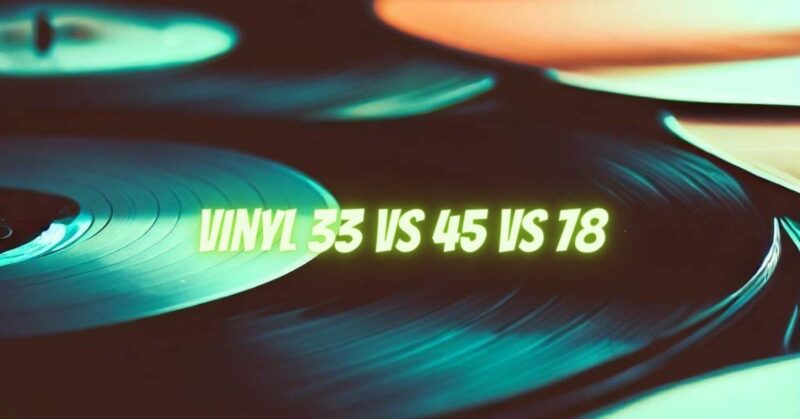Vinyl records have captivated music lovers for decades, and each speed has its own unique characteristics. The three primary speeds for vinyl playback are 33, 45, and 78 revolutions per minute (RPM). In this article, we’ll explore the differences between these speeds and shed light on the distinct experiences they offer, helping you navigate the vinyl trinity and make informed choices when building your record collection.
- 33 RPM Records:
a. Duration and Format: 33 RPM records are commonly used for full-length albums. They offer longer playing times per side, allowing for a greater number of tracks or extended compositions. These records typically have a larger diameter of 12 inches (30.5 cm) and utilize wider grooves to accommodate the longer playing time.
b. Sound Quality: Due to the slower rotation speed and wider grooves, 33 RPM records generally provide extended frequency response, deeper bass, and more dynamic range. They are well-suited for genres that benefit from a warm, immersive sound, such as rock, pop, and jazz.
- 45 RPM Records:
a. Singles and EPs: 45 RPM records are commonly associated with singles and EP releases. They have a smaller diameter of 7 inches (17.8 cm) and feature narrower grooves. This format allows for shorter playing times per side, typically accommodating one song per side.
b. Sound Quality: The higher rotational speed of 45 RPM records enables more detailed sound reproduction. They offer enhanced clarity, tighter bass response, and increased high-frequency fidelity. Genres like jazz, classical, and audiophile recordings can particularly benefit from the higher resolution provided by 45 RPM records.
- 78 RPM Records:
a. Early Era: 78 RPM records were prevalent during the early years of recorded music and were made from shellac rather than vinyl. These records have a larger diameter of 10 inches (25.4 cm) and utilize wider grooves. They were primarily used before the introduction of the microgroove technology employed in later vinyl records.
b. Sound Quality: While 78 RPM records have limited frequency response and dynamic range compared to modern vinyl records, they possess a unique charm and historical significance. They offer a vintage sound aesthetic and are ideal for early jazz, blues, and historical recordings.
Table of Differences
| Feature | 33 1/3 RPM | 45 RPM | 78 RPM |
|---|---|---|---|
| Rotation speed | 33 1/3 RPM | 45 RPM | 78 RPM |
| Playing time per side | About 20 minutes | About 5 minutes | About 2 minutes |
| Frequency response | Narrower | Wider | Narrowest |
| Dynamic range | Lower | Higher | Lowest |
| Transient response | Slower | Faster | Slowest |
Conclusion:
Understanding the differences between 33, 45, and 78 RPM records allows you to tailor your vinyl collection to suit your preferences and musical tastes. The slower rotation speed and wider grooves of 33 RPM records provide a warm and immersive sound, making them suitable for full-length albums. 45 RPM records, with their higher speed and narrower grooves, offer enhanced clarity and resolution, making them perfect for singles and audiophile releases. Meanwhile, 78 RPM records preserve the charm of early recordings and serve as a window into the musical past.
By appreciating the unique qualities of each speed, you can curate a diverse collection that covers a wide range of musical genres and eras. Whether you’re captivated by the longevity of albums, the energy of singles, or the historical significance of early recordings, the vinyl trinity of 33, 45, and 78 RPM records ensures a rich and rewarding listening experience.


